Medical malpractice lawsuits are complex and often high-stakes legal matters. Understanding the legal process involved is crucial for both victims of medical negligence and healthcare providers facing allegations of malpractice. This guide provides a comprehensive overview of the legal process in medical malpractice lawsuits, covering the key elements of medical malpractice, the steps involved in a lawsuit, the burden of proof, common defenses, and ethical considerations.
Navigating the legal process in medical malpractice cases requires a thorough understanding of the legal standards of care, negligence, causation, and damages. It is essential to identify the roles of plaintiffs, defendants, and their attorneys, as well as the process of filing a complaint, discovery, and trial.
Elements of Medical Malpractice
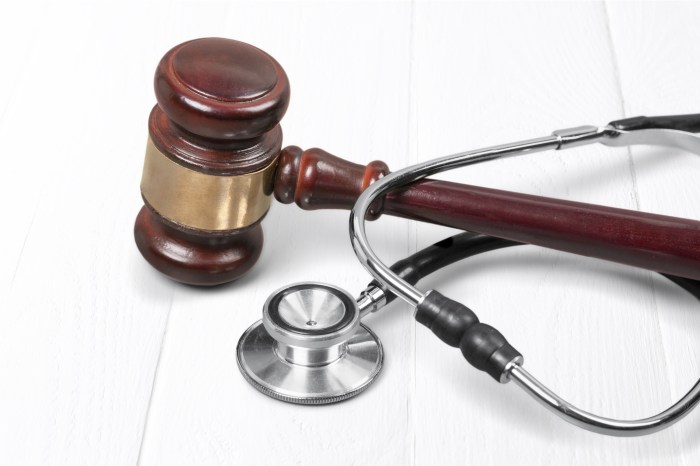
Medical malpractice occurs when a healthcare professional’s negligence causes harm to a patient. To establish medical malpractice, several key elements must be proven:
-
-*Duty of Care
The healthcare professional must have owed the patient a duty of care, such as a doctor-patient relationship.
-*Breach of Duty
The healthcare professional must have breached their duty of care by failing to meet the accepted standard of care.
-*Causation
The healthcare professional’s breach of duty must have caused the patient’s injuries or damages.
-*Damages
The patient must have suffered damages, such as physical pain, emotional distress, or financial loss.
Legal Standards of Care and Negligence
The legal standard of care is the level of skill and care that a reasonably prudent healthcare professional would have exercised under similar circumstances.
Negligence occurs when a healthcare professional fails to meet this standard, resulting in harm to the patient.
Causation
Causation requires proving that the healthcare professional’s breach of duty directly and proximately caused the patient’s injuries. This can be established through expert testimony or other evidence.
Damages
Damages in medical malpractice cases can include compensation for medical expenses, lost wages, pain and suffering, and other losses. The amount of damages awarded is determined by the severity of the injuries and the extent of the patient’s losses.
The Legal Process
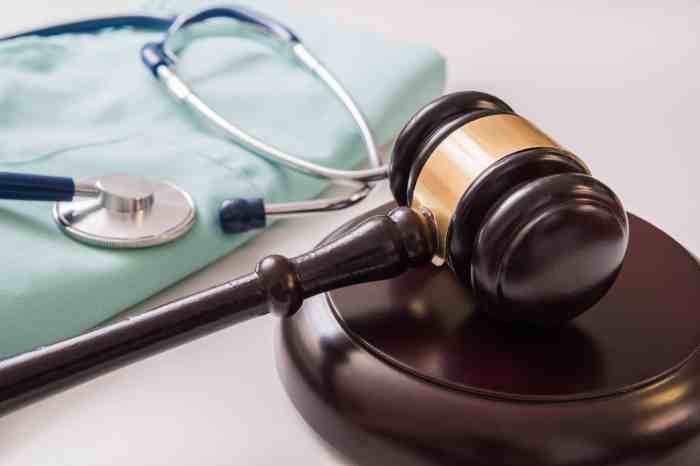
Medical malpractice lawsuits are complex legal proceedings that involve several distinct steps. Understanding the process can help individuals involved in such cases navigate the legal system effectively.
The legal process typically begins with the plaintiff, the individual who claims to have suffered harm due to medical negligence, filing a complaint against the defendant, the healthcare provider or institution alleged to have caused the harm. The complaint Artikels the specific allegations of negligence and the damages sought by the plaintiff.
Roles of Plaintiffs, Defendants, and Attorneys
In a medical malpractice lawsuit, the plaintiff is the person who has suffered harm due to alleged medical negligence. The defendant is the healthcare provider or institution being sued. Both parties are represented by attorneys who advocate for their respective interests throughout the legal process.
Filing a Complaint
The first step in a medical malpractice lawsuit is filing a complaint. The complaint is a legal document that Artikels the plaintiff’s allegations against the defendant. It must be filed within a specific time frame, known as the statute of limitations, which varies by jurisdiction.
Discovery
Discovery is a phase of the legal process where both parties exchange information and documents related to the case. This can include medical records, witness statements, and expert reports. Discovery helps both parties prepare for trial and narrow down the issues in dispute.
Trial
If the case cannot be resolved through settlement negotiations, it will proceed to trial. At trial, both parties present their evidence and arguments to a judge or jury. The jury or judge will then decide whether the defendant is liable for the plaintiff’s injuries and, if so, the amount of damages to be awarded.
Proving Medical Malpractice
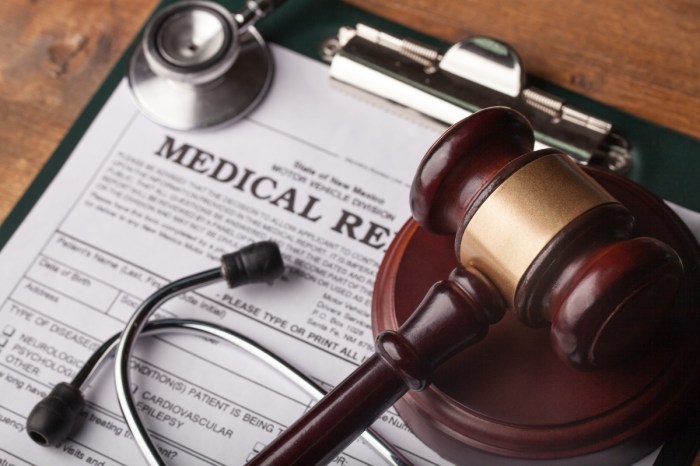
Establishing medical malpractice requires proving that a healthcare professional’s negligence caused harm to a patient. The burden of proof lies with the plaintiff, who must demonstrate that the defendant deviated from the accepted standard of care, resulting in injury.
Types of Evidence
Various types of evidence can be used to prove negligence in medical malpractice cases:
- Medical records: Documenting the patient’s medical history, diagnosis, treatment, and outcome.
- Expert testimony: Statements from qualified medical professionals who can provide opinions on the standard of care and whether it was breached.
- Physical evidence: Medical devices, implants, or other physical objects related to the alleged malpractice.
li> Witness testimony: Statements from healthcare providers, patients, or other individuals who witnessed the events in question.
Expert Witnesses
Expert witnesses play a crucial role in medical malpractice cases by providing specialized knowledge and opinions.
They can:
- Establish the applicable standard of care.
- Analyze medical records and provide interpretations.
- Testify about the cause and extent of the patient’s injuries.
- Offer opinions on whether the defendant’s actions or omissions constituted negligence.
Medical Records
Medical records serve as vital evidence in medical malpractice cases, providing a detailed account of the patient’s medical history and treatment. They can:
- Document the patient’s symptoms, diagnosis, and treatment plan.
- Provide evidence of the healthcare professional’s actions or omissions.
- Support expert witness testimony by providing factual basis for opinions.
- Assist in establishing causation between the defendant’s actions and the patient’s injuries.
Defenses to Medical Malpractice

In medical malpractice lawsuits, the defendant (typically the healthcare provider or medical facility) may raise various defenses to counter the plaintiff’s claims. These defenses aim to establish that the plaintiff’s injuries or damages were not caused by the healthcare provider’s negligence or that the plaintiff’s own actions contributed to the outcome.
Contributory Negligence and Assumption of Risk
Contributory negligence is a defense that alleges the plaintiff’s own negligence contributed to their injuries. If the jury finds the plaintiff partially responsible for their damages, their compensation may be reduced in proportion to their degree of fault. Assumption of risk, on the other hand, occurs when the plaintiff knowingly and voluntarily exposes themselves to a known risk of harm.
Statutes of Limitations and Caps on Damages
Statutes of limitations impose a time limit within which a plaintiff must file a medical malpractice lawsuit. If the lawsuit is filed after the expiration of the statute of limitations, it may be barred from proceeding. Additionally, some jurisdictions have laws that cap the amount of damages that can be awarded in medical malpractice cases, limiting the plaintiff’s potential recovery.
Resolving Medical Malpractice Cases

Medical malpractice cases can be resolved through various methods, each with its advantages and disadvantages. Understanding these methods is crucial for both patients and healthcare providers involved in such cases.
Settlement
Settlement is a common method of resolving medical malpractice cases. It involves negotiations between the plaintiff (the patient) and the defendant (the healthcare provider or institution) to reach an agreement that compensates the plaintiff for their damages without going to trial.
- Pros:
- Quicker and less expensive than going to trial
- Allows parties to maintain confidentiality
- Avoids the uncertainty of a trial outcome
- Cons:
- May not result in full compensation for the plaintiff
- Can be challenging to negotiate a fair settlement
- May not provide closure or a public acknowledgment of wrongdoing
Mediation
Mediation is a form of alternative dispute resolution where a neutral third party (the mediator) facilitates negotiations between the parties. The mediator helps the parties communicate effectively, explore settlement options, and reach a mutually acceptable agreement.
- Pros:
- Less adversarial than a trial
- Facilitates communication and understanding
- Can help parties avoid the costs and risks of a trial
- Cons:
- Not binding unless an agreement is reached
- Can be time-consuming
- May not result in a resolution if parties are unable to compromise
Arbitration
Arbitration is a form of binding dispute resolution where a neutral third party (the arbitrator) hears evidence and makes a decision that is legally binding on both parties. Arbitration is typically faster and less expensive than a trial.
- Pros:
- Faster and less expensive than a trial
- Provides a binding decision
- Can be confidential
- Cons:
- Less opportunity for discovery and cross-examination
- Limited right to appeal
- May not be as impartial as a trial
The Role of Courts
Courts play a significant role in resolving medical malpractice cases that cannot be settled through alternative dispute resolution methods. In a trial, a judge or jury hears evidence from both parties and determines whether the healthcare provider was negligent and liable for the plaintiff’s damages.
- Pros:
- Provides a public forum for resolving disputes
- Allows for a thorough examination of evidence
- Ensures due process and fairness
- Cons:
- Can be lengthy and expensive
- May not result in a clear or satisfactory outcome
- Can be emotionally taxing for the parties involved
Ethical Considerations in Medical Malpractice Lawsuits
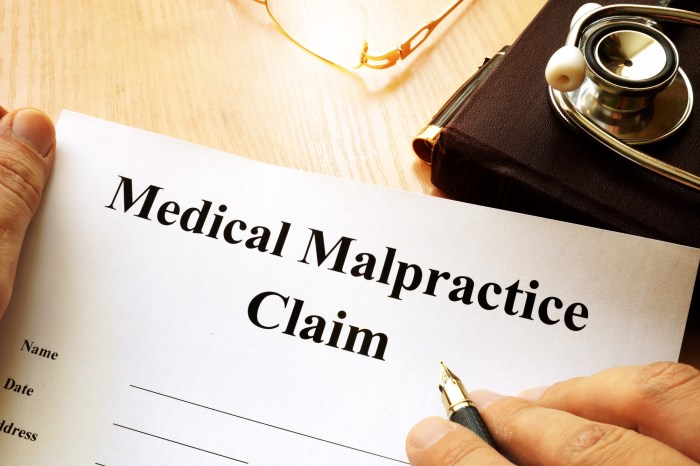
Attorneys in medical malpractice cases have a number of ethical obligations, including the duty to provide competent representation, maintain confidentiality, and avoid conflicts of interest. It is important for attorneys to be aware of these obligations and to take steps to comply with them.
One of the most important ethical obligations of attorneys in medical malpractice cases is the duty to provide competent representation. This means that attorneys must have the knowledge and skills necessary to handle medical malpractice cases effectively. Attorneys must also be able to communicate effectively with their clients and to keep them informed about the progress of their cases.
Potential Conflicts of Interest and Biases
Attorneys in medical malpractice cases must also be aware of potential conflicts of interest and biases. A conflict of interest exists when an attorney has a personal or financial interest in the outcome of a case that could impair their ability to represent their client objectively.
For example, an attorney who has a financial interest in a medical practice may be less likely to vigorously pursue a medical malpractice case against that practice.
Biases are also a concern in medical malpractice cases. Biases can be based on a variety of factors, such as race, gender, or religion. Attorneys must be aware of their own biases and take steps to avoid letting them influence their representation of their clients.
Maintaining Confidentiality and Professionalism
Attorneys in medical malpractice cases must also maintain confidentiality and professionalism. This means that attorneys must keep their clients’ information confidential and must not engage in any conduct that could harm their clients’ reputations.
Attorneys must also be respectful of the court and the opposing parties. Attorneys must not engage in any conduct that could disrupt the proceedings or delay the resolution of the case.
Last Word
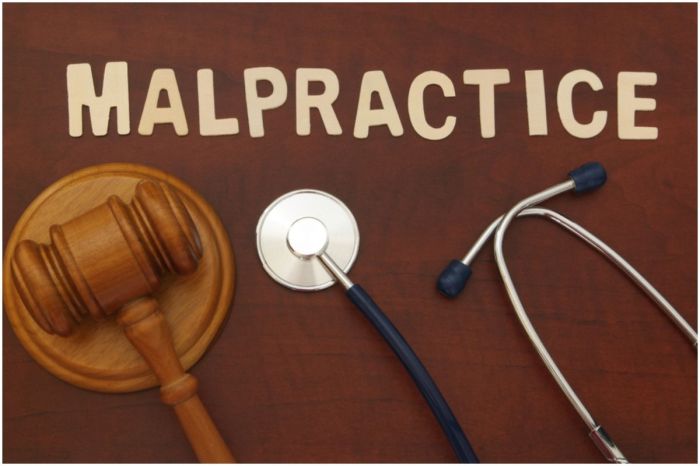
Understanding the legal process in medical malpractice lawsuits empowers individuals to make informed decisions about their rights and options. By providing a clear and concise overview of the legal process, this guide serves as a valuable resource for anyone seeking to understand the complexities of medical malpractice litigation.
FAQ Corner
What is the burden of proof in medical malpractice cases?
The burden of proof in medical malpractice cases lies with the plaintiff, who must prove that the healthcare provider breached the duty of care, caused the plaintiff’s injuries, and that the plaintiff suffered damages as a result.
What are common defenses to medical malpractice claims?
Common defenses to medical malpractice claims include contributory negligence, assumption of risk, and statutes of limitations.
What are the different methods of resolving medical malpractice cases?
Medical malpractice cases can be resolved through settlement, mediation, arbitration, or trial.



